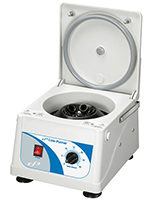Six Types of Centrifuges
From microbiology to tissue culture to pharmaceutical research,centrifuges need to deliver consistent performance in the laboratory. They fulfill critical duties such as separating sugar from liquids to isolating sludge from water in pulp and paper mills. The best options also enhance lab safety.
Many types of centrifuges are available—here are six common types:

Cole-Parmer® Centrifuge, Variable Speed
- General-purpose centrifuges can be used for many applications; some units include a variety of rotors and adapters for flexibility.
- Microcentrifuges hold small tubes and have a smaller footprint on your lab countertop. They may also be more affordable.
- Fixed-speed microcentrifuges (or may be referred to as dual speed).
- Refrigerated microcentrifuges for samples requiring consistent temperatures. Your centrifuge should be able to run at its maximum speed and still maintain a consistent temperature.
- Pre-clinical centrifuges include small benchtop models and fixed speed or variable speed models.
- Specialty centrifuges, such as those centrifuges for Babcock Systems, specifically designed for Babcock Testing.
In addition to size and price, other features to consider:
- Anticorrosive material: Carbon fiber is durable and lightweight, and will hold up longer over time than metal or aluminum components.
- Rotor versatility: If you perform multiple tasks, choose a centrifuge that accommodates a variety of adapters. Select a model that doesn't require the use of tools and that is ergonomically sound.
- Throughput: Look for versatility in rotor and adapter options so that you can use your centrifuge to its optimal capacity.
Comentarios
Publicar un comentario